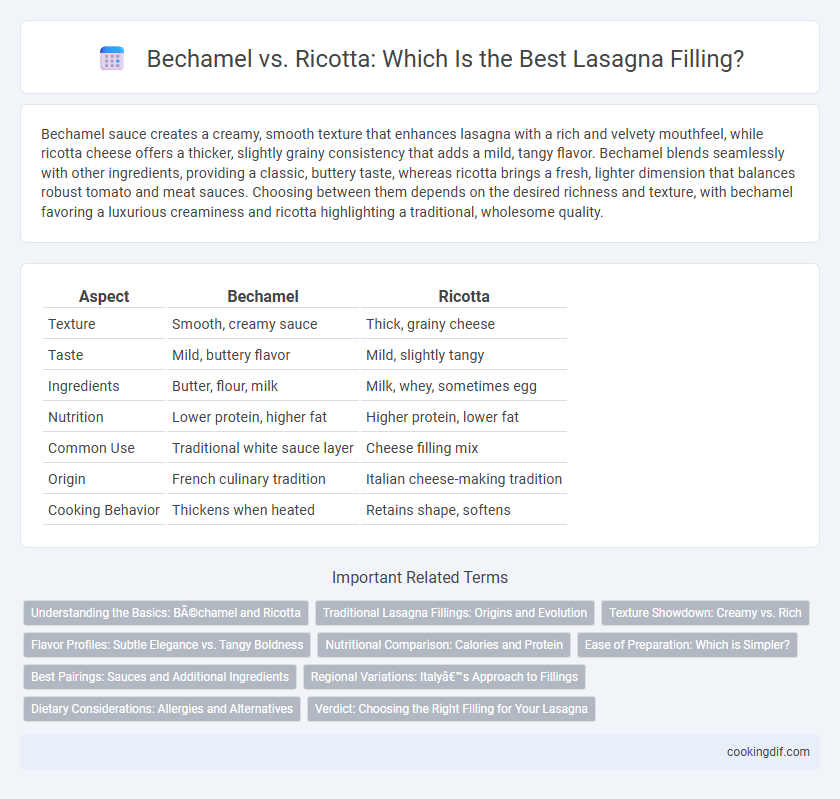Bechamel sauce creates a creamy, smooth texture that enhances lasagna with a rich and velvety mouthfeel, while ricotta cheese offers a thicker, slightly grainy consistency that adds a mild, tangy flavor. Bechamel blends seamlessly with other ingredients, providing a classic, buttery taste, whereas ricotta brings a fresh, lighter dimension that balances robust tomato and meat sauces. Choosing between them depends on the desired richness and texture, with bechamel favoring a luxurious creaminess and ricotta highlighting a traditional, wholesome quality.
Table of Comparison
| Aspect | Bechamel | Ricotta |
|---|---|---|
| Texture | Smooth, creamy sauce | Thick, grainy cheese |
| Taste | Mild, buttery flavor | Mild, slightly tangy |
| Ingredients | Butter, flour, milk | Milk, whey, sometimes egg |
| Nutrition | Lower protein, higher fat | Higher protein, lower fat |
| Common Use | Traditional white sauce layer | Cheese filling mix |
| Origin | French culinary tradition | Italian cheese-making tradition |
| Cooking Behavior | Thickens when heated | Retains shape, softens |
Understanding the Basics: Béchamel and Ricotta
Bechamel sauce, a classic white sauce made from butter, flour, and milk, provides a creamy, smooth texture and mild flavor that enhances the layers of lasagna without overpowering other ingredients. Ricotta cheese offers a richer, denser filling with a slightly grainy texture and a tangy, fresh taste that pairs well with spinach, herbs, and cheeses. Selecting between bechamel and ricotta depends on desired creaminess, flavor profile, and traditional regional preferences within Italian cuisine.
Traditional Lasagna Fillings: Origins and Evolution
Traditional lasagna fillings typically feature bechamel sauce, a classic French white sauce made from butter, flour, and milk, prized for its smooth, creamy texture and rich flavor. In contrast, ricotta cheese, a staple in Italian-American lasagna recipes, offers a lighter, tangier filling derived from whey, contributing to a less dense, more textured layering. The evolution from bechamel to ricotta in many lasagna recipes reflects regional adaptations and preferences, balancing creaminess and moisture to achieve distinct culinary experiences.
Texture Showdown: Creamy vs. Rich
Bechamel sauce offers a smooth, creamy texture that coats lasagna layers with a velvety richness, enhancing moisture without heaviness. Ricotta provides a thicker, grainier consistency that adds a hearty, rustic element, contributing a rich mouthfeel with mild tanginess. The choice between bechamel and ricotta significantly influences lasagna's texture, balancing creaminess for silkiness or a denser, more substantial bite.
Flavor Profiles: Subtle Elegance vs. Tangy Boldness
Bechamel sauce offers a creamy, subtle elegance with its smooth, buttery texture and delicate hints of nutmeg, creating a rich yet understated filling for lasagna. Ricotta provides a tangy boldness, introducing a slightly grainy texture and a fresh, mildly acidic flavor that contrasts with the savory layers of meat and tomato sauce. Choosing between Bechamel and Ricotta depends on whether a lasagna aims for classic richness or a vibrant, tangy depth in its flavor profile.
Nutritional Comparison: Calories and Protein
Bechamel sauce typically contains around 70-100 calories per 1/4 cup serving with about 2-3 grams of protein, due to its butter, flour, and milk base. Ricotta cheese offers approximately 100-110 calories per 1/4 cup with a higher protein content of 6-7 grams, making it a richer source of protein for lasagna filling. Choosing ricotta enhances the dish's protein profile while bechamel contributes creaminess with fewer calories.
Ease of Preparation: Which is Simpler?
Bechamel sauce, made from butter, flour, and milk, offers a smooth, creamy texture but requires careful whisking to avoid lumps, demanding moderate cooking skills. Ricotta cheese, on the other hand, is ready to use straight from the container, making it a simpler and quicker option for filling lasagna without the need for stovetop preparation. Choosing ricotta enhances ease of preparation while bechamel provides a more refined texture for those comfortable with basic sauce-making techniques.
Best Pairings: Sauces and Additional Ingredients
Bechamel sauce pairs perfectly with rich meat ragu and tender pasta sheets, offering a creamy, velvety texture that balances savory flavors in classic lasagna. Ricotta cheese provides a lighter, slightly tangy filling that works best with vegetable-based sauces like spinach or mushroom ragu, enhancing freshness without overpowering other ingredients. Combining Bechamel with Parmigiano-Reggiano and Ricotta with fresh herbs such as basil or parsley elevates the dish's complexity and depth.
Regional Variations: Italy’s Approach to Fillings
In Italian regional variations, bechamel sauce is traditionally favored in northern Italy, particularly in Emilia-Romagna, where it adds a creamy texture and subtle richness to lasagna fillings. In contrast, southern regions like Campania prefer ricotta cheese, offering a lighter, tangier alternative that complements fresh tomato-based sauces and local herbs. These regional preferences reflect Italy's diverse culinary heritage, influencing lasagna recipes with unique textures and flavor profiles based on local ingredients and traditions.
Dietary Considerations: Allergies and Alternatives
Bechamel sauce, made from butter, flour, and milk, contains dairy and gluten, posing challenges for individuals with lactose intolerance or gluten allergies. Ricotta, primarily a soft cheese, also has dairy but lacks gluten, making it a safer choice for gluten-sensitive diets while still problematic for lactose-intolerant individuals. Alternatives for these fillings include plant-based bechamel using almond or oat milk with gluten-free flour, and vegan ricotta made from tofu or cashews, accommodating both dairy-free and gluten-free dietary restrictions.
Verdict: Choosing the Right Filling for Your Lasagna
Bechamel sauce provides a creamy, smooth texture with a subtle buttery flavor that enhances the overall richness of lasagna, making it ideal for traditional Italian recipes. Ricotta offers a lighter, slightly grainy consistency with a mild, tangy taste that pairs well with vegetable or meat layers for a healthier, fresher option. Selecting between bechamel and ricotta depends on desired creaminess and dietary preferences, with bechamel favored for luxurious mouthfeel and ricotta preferred for lighter, protein-rich fillings.
Béchamel vs Ricotta for filling Infographic

 cookingdif.com
cookingdif.com